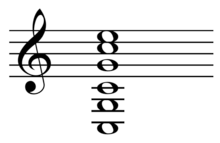Open C tuning
Open C tuning is an open tuning for guitar. The open-string notes form a C major chord, which is the triad (C,E,G) having the root note C, the major third (C,E), and the perfect fifth (C,G). When the guitar is strummed without fretting any strings, a C-major chord is sounded. By barring all of the strings for one fret (from one to eleven), one finger suffices to fret the other eleven major-chords.

Examples
There are several open C tunings.
Repetitive C-E-G-C-E-G
The English guitar uses a repetitive open-C tuning
- C-E-G-C-E-G,
which is approximately a major-thirds tuning,[1] specifically
- C-E-G♯-C-E-G♯=C-E-A♭-C-E-A♭.
"C5" variant C-G-C-G-G-E
This open C tuning was used by Soundgarden for songs including Pretty Noose, Burden in My Hand, and Head Down. Chord sequences often omit the high E string, leaving the power chord ubiquitous to Grunge music.[2]
C-G-C-G-C-E
- C-G-C-G-C-E.[3]
This open C tuning was used by William Ackerman for his "Townshend Shuffle", by John Fahey for his tribute to Mississippi John Hurt,[4] and by Led Zeppelin's Jimmy Page for "Friends".[5][6] It is also used by Devin Townsend for his work with Strapping Young Lad and The Devin Townsend Project.[7]
Overtones C-C-G-C-E-G
- C-C-G-C-E-G[8]
Another open C tuning uses the harmonic sequence (overtones) of the note C. When an open-note C-string is struck, its harmonic sequence begins with the notes (C,C,G,C,E,G,B♭,C). The root note is associated with a sequence of intervals, beginning with the unison interval (C,C), the octave interval (C,C), the perfect fifth (C,G), the perfect fourth (G,C), the major third (C,E), and the minor third (E,G); in particular, this sequence of intervals contains the thirds of the C-major chord {(C,E),(E,G)}.[9]
C-minor open chord: Cross-note tuning
Flattening this open tuning's open-note E to E♭ changes the open chord from C-major to C-minor, so producing the cross-note tuning
- C-C--G-C-E♭-G
which enables one-finger minor chords. Like other cross-note tunings, it also allows major chords to be fretted with one adjacent finger.[10]
Relation to new standard tuning
Many of the notes from the harmonic sequence for C appear in the new standard tuning (NST),[11] which is a nearly regular tuning based on perfect fifths; NST also has (D,A) from the pentatonic scale on C:
- C-G-D-A-E-G
NST is used in Guitar Craft (a school of guitar playing founded by King Crimson's Robert Fripp). The open-C overtones tuning has the same range as NST, which can use extreme strings (.011 and .059 inches).[12]
C-C-G-C-E-C
- C-C-G-C-E-C
Using a high C rather than the high G of the overtone series, this open C tuning was used by Mick Ralphs for the songs "Can't Get Enough" and "Movin' On" on Bad Company's debut album. Ralphs said, "It needs the open C to have that ring," and "it never really sounds right in standard tuning".[13]
Notes
- Annala, Hannu; Mätlik, Heiki (2007). "Composers for other plucked instruments: Rudolf Straube (1717–1785)". Handbook of guitar and lute composers (Translated by Katarina Backman ed.). Mel Bay. p. 30. ISBN 0786658444.CS1 maint: ref=harv (link)
- "wikiHow to Write a Grunge Song". Retrieved May 25, 2017.
- Baughman, Steve (2004). "Open C". Mel Bay Beginning Open Tunings. Mel Bay Publications. pp. 8–14. ISBN 978-0-7866-7093-2.
- Sethares (2009, pp. 18–19)
- Prown, Pete; Newquist, HP (1997). "Chapter Nine Hard rock and heavy metal: The birth of a behemoth". Legends of Rock Guitar: The Essential Reference of Rock's Greatest Guitarists. Hal Leonard Corporation. p. 61.CS1 maint: ref=harv (link)
- Page's "Friends" tuning is called an C6 chord (C-A-C-G-C-E) in Page 92: Welch, Chris (1998). Led Zeppelin: Dazed and confused: The stories behind every song. ISBN 1-56025-818-7.CS1 maint: ref=harv (link)
- Devin Townsend Masterclass: GuitarMessenger.com at 4:30
- Guitar Tunings Database (2013). "CCGCEG Guitar Tuner". CCGCEG: Open C via harmonic overtones. Archived from the original on 10 March 2013. Retrieved 20 February 2013.CS1 maint: ref=harv (link)
- Persichetti (1961, pp. 23–24): Persichetti, Vincent (1961). Twentieth-century harmony: Creative aspects and practice. New York: W. W. Norton. ISBN 0-393-09539-8. OCLC 398434.CS1 maint: ref=harv (link)
- Sethares (2001, p. 16)
- Ball, Steve (3 January 2006). "Steve Ball music diary Tuesday, January 03, 2006". steveball.com. Steve Ball at AllMusic. Retrieved 29 February 2012.CS1 maint: ref=harv (link)
- Cleveland, Barry (1 December 2004). "California Guitar Trio (Interview)" (PDF). Frets Magazine (Fall). Retrieved 25 March 2012. (subscription required)
- Sharken, Lisa (15 May 2001). "Mick Ralphs: The rock 'N' roll fantasy continues". Vintage Guitar. Retrieved 21 February 2013.CS1 maint: ref=harv (link)
References
- Sethares, Bill (2009) [2001]. "Open tunings". Alternate tuning guide (pdf). Madison, Wisconsin: University of Wisconsin; Department of Electrical Engineering.CS1 maint: ref=harv (link)